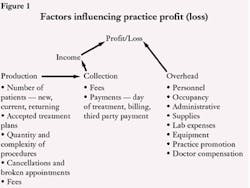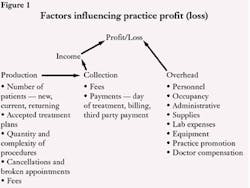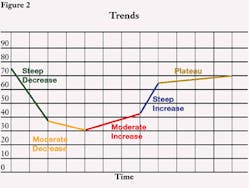HOW TO PROFIT FROM...software: Don't let the numbers fool (or scare) you!
Steven Schwartz, DDS
This article originally appeared in the Journal of Contemporary Dental Practice, Winter 2002, Volume 3, No.1 under the title, "Managing Practice Statistics for Practice Succcess" and is reprinted with permission.
Office computers have enabled dentists and staff to quickly access information crucial for monitoring practice growth and vitality. But how do you use that data to control changing economics?
Customer satisfaction surveys provide a subjective picture of how a practice is perceived by its patients, but objective information is needed to monitor practice growth. This is accomplished by collecting and charting statistical data about the practice to determine how they relate to each other. Compilation of data enables the dentist and staff to recognize trends that will affect growth and profitability. They are also used to develop strategies that reinforce positive trends and reverse negative trends.
Determining profit and loss
The major indicator of practice health is profit (or loss). The amount of profit a practice exhibits is based on income minus costs (overhead). When income is greater than overhead, there is a profit. Conversely, when income is less than overhead, there is a loss. The amount of income and overhead are determined by a number of factors. These factors and how they impact on each other are illustrated in Figure 1.
Income is determined by the collection of fees generated through the production of services. In an ideal world the fees collected would be equal to production. The amount of production generated is affected by:
- The number of patients (new, current, returning)
- The number of accepted treatment plans
- The quantity and complexity of treatment rendered
- Cancellations and broken appointments
- Fees charged
The amount of fees collected is based on accounts receivable management and insurance claim processing, as well as the amount of production.
Practice overhead consists of expenditures for the following:
- Personnel
- Occupancy (rent, mortgage, utilities, repairs)
- Administrative expenses
- Supplies (clinical and clerical)
- Lab expenses
- Equipment (purchase, lease, maintenance)
- Practice promotion
- Doctor compensation
These factors and sub-factors are divided into two groups: positive statistics and negative statistics. As the numeric value of a positive statistic increases, the health and growth of the practice increases. Conversely, as the numeric value of a negative statistic increases, the health and growth of the practice decreases.
Sharing the data
For the practice to benefit from statistical analysis, it is imperative the dentist and the staff are involved in tracking the numbers. Weekly and monthly data are collected and recorded by the dentist and staff. The financial administrator is responsible for monthly production and collections. Hygienists track new and recall patients. The scheduling coordinator monitors broken appointments and cancellations. The dentist is responsible for overhead. The information gathered by these individuals is shared with the whole team at monthly meetings.
The statistical data collected is recorded on a profit and loss graph as shown in Figure 2. Just as a picture is worth a thousand words, data expressed in a linear graph is easier to visualize and enables the team to track trends and make the necessary adjustments. Every statistic that is tracked has its own graph except for collection and overhead, which are recorded on the same graph.
The horizontal axis of the graph represents "time," with each division representing days, weeks or months. The vertical axis represents the value of the measured statistic, with each division representing the measured statistic. The highest and lowest division should be approximately twice the average values of the collected data. For example, when charting monthly production in a practice producing $50,000 per month, the divisions on the vertical axis range from zero to 100,000. In a graph measuring the number of new patients per month in a practice with 30 new patients a month, the divisions run from zero to 60. Over time, as the statistic approaches either end of the scale, the divisions are adjusted.
Tracking trends
Each month the statistical information is collected, recorded, plotted on the graph, and analyzed by the entire staff. This is compared to the previous month and previous year. The staff also determines whether a trend is developing. A trend develops when a statistical value increases, decreases, or remains the same over a two-month period. Trends are grouped into five categories: steep decreasing, moderate decreasing, moderate increasing, steep increasing, and plateau.
If a statistic is increasing or decreasing at a rapid rate, it is steep. If it is increasing or decreasing at a slower rate, it is moderate. A plateau trend occurs when a steep trend tapers into a moderate trend. The rate of increase or decrease of a trend is calculated by measuring the angle between lines formed by a trend and the horizontal axis. A steep trend has an angle greater than 45 degrees, and a moderate trend has an angle less than 45 degrees.
Responding to the data
Once the trend is categorized, specific steps are taken to control and modify it. The four steps are:
- Assign responsibility - Depending on the category of the trend, the dentist or a staff member takes overall responsibility for investigating and, if necessary, modifying the trend.
- Identify the problem - Identify the area causing the problem. The dentist and staff investigate the factors responsible for the trend. Trends and statistics of other areas of the practice are examined and compared. For example, if there is a drop in collection, a corresponding reduction in the number of insurance claims processed may point to the cause of the problem.
- Take action - Do whatever action is necessary to correct the problem identified in Step 2. This may include increasing external and internal marketing, increasing the number and type of procedures performed, increased training for the entire team, changing office policy, or ensuring that current office policy is observed.
- Monitor the situation - Depending on the category of the trend, the statistic may be monitored daily, weekly or monthly. In a steeply decreasing trend, the statistics are monitored daily or weekly. In a moderately decreasing trend, the statistics are monitored weekly. In any category of increasing trends or in a plateau trend, the statistics are monitored monthly.
Steep decreasing trends
For a positive statistic exhibiting a steep decreasing trend, the follow actions are taken:
- Assign responsibility - This trend indicates there are major problems in the practice, and it is imperative that changes be made immediately. The dentist must exhibit strong leadership and control and, for that reason, usurps the authority of other team members in the practice. The dentist undertakes ultimate responsibility for identifying the basis of the trend, changing and instituting practice policies, and monitoring the staff's compliance.
- Identify the problem - The dentist identifies the source of the problem by asking staff and patients for their perception of the cause of the decreasing statistic. The dentist examines statistical trends in all areas of the practice and compares them with each other to isolate problems. For example, if there is a decrease in production, a corresponding decrease in the number of patients returning for their recall exams may suggest a cause for the problem.
- Take action - Do whatever is necessary to correct the problem. In the above example the staff surveys patients to see why they are not returning. Are they being contacted by the office to return for recall visits? If not, is it because of a staff problem or procedural problem? If the problem is the result of a team member's failure in following office procedure, the team member is re-educated in office policy or relieved of the responsibility. If office policy is being followed, re-evaluation of the efficacy of the policy may be necessary. In this example, the practice may switch from mailing reminder postcards to patients to pre-appointing patients for their next recall appointment.
- Monitor the situation - The dentist undertakes full responsibility for monitoring the trend. Statistics are recorded and examined on a daily or weekly basis. The staff still may be responsible for gathering the statistics, but the dentist carefully reviews and analyzes the information.
Moderate decreasing trends
For a positive statistic exhibiting a moderate decreasing trend, the following actions are taken:
- Assign responsibility - As this trend is less critical than the steep decreasing trend, staff members join the dentist in investigating the declining trend.
- Identify the problem - As in the steep decreasing trend, the cause of the problem is identified. In this trend, the staff assumes more responsibility. As before, the staff compares the practice trends to isolate problems.
- Take action - In a moderately decreasing trend, office policies do not have to be changed - just followed. Staff members should be monitored to see if they are following proper procedure. If they are not, they are shown how their actions affect office income and are corrected.
Efforts are made to economize, and supply purchasing is controlled. The office does not make any major purchases or take on additional debt. Minor adjustments may be needed in operational procedures and staff responsibilities, but major changes are not needed.
- Monitor the situation - Statistics are monitored weekly until the trend becomes positive. The staff is responsible for monitoring the statistics and keeping other staff members apprised of the findings.
Moderate increasing trends
For positive statistics exhibiting a moderate increasing trend, the following steps are taken.
- Assign responsibility - Both dentist and staff have the responsibility of investigating the moderately increasing trend.
- Identify - Areas that are doing well and areas that are not doing well are identified and analyzed. Statistics and trends in other areas are compared to each other.
- Action - In areas that are doing well, do not make major changes. Compliment and reward staff members who are responsible for improving a trend. If a statistic is not improving or worsens, find out why and return to the steps outlined in the previous sections.
- Monitor - The dentist and staff monitor the statistic monthly.
Steep increasing trends
For a positive statistic exhibiting a steep increasing trend, the following actions are taken:
- Determine responsibility - All staff members are involved with monitoring the steep increasing trend.
- Identify - Identify those areas that are doing well and those that are not, although in this trend most areas often do well.
- Actions - As in the moderate increasing trend, do not change anything. The dentist and staff should continue doing whatever they have been doing to improve the statistics.
For example, if a policy of contacting patients after undergoing difficult treatment was instituted and it resolved a decreasing trend then the policy should continue. Success should not make the dentist indifferent or careless.
Short-term, high interest debts (credit card, unpaid bills) undertaken in a poor cash flow period are paid first. Investments to improve service facilities that will increase the efficiency and production of the practice are made.
It is not until the previous steps are undertaken do the dentist and staff reward themselves with raises and bonuses.
- Monitor - Statistics are monitored monthly. The dentist and staff should be prepared to take steps to correct a falling trend.
Plateau trends
For a positive trend exhibiting a plateau, the following steps are taken:
- Assign responsibility - All staff members are responsible for investigating the trend.
- Identify - A plateau occurs after a steep increasing trend reverts into a moderately increasing trend. The staff must determine if the leveling is caused by negative statistics showing increasing influence or if it is caused by physical or external limitations. For example, a practice that has experienced a steep increase in the number of new patients eventually will be unable to accommodate requests for appointments because of lack of chair time.
Increasing the amount of time a patient has to wait for an appointment does not increase production with the accompanying increase in revenues. All it does is put additional stress on the staff responsible for scheduling.
The dentist can consider a variety of solutions for accommodating the increased demand for appointments. The dentist can:
- Increase the number of chairs by expanding office space.
- Increase the number of hours devoted to patient care by increasing the dentist's workweek or incorporating an associate dentist or auxiliary staff into the practice.
- Reduce the number of patients by increasing fees.
The first two solutions will eliminate the problem of accommodating patients but may not provide additional profit to the practice because of increased costs for construction, equipment, and personnel. They may also result in increased stress for the dentist and existing staff. The solution of increased fees won't accommodate new patients but will reduce the demand for appointments. The increased fees will result in additional income to the practice with the accompaniment of increased overhead. The ultimate solution rests with the dentist and staff.


